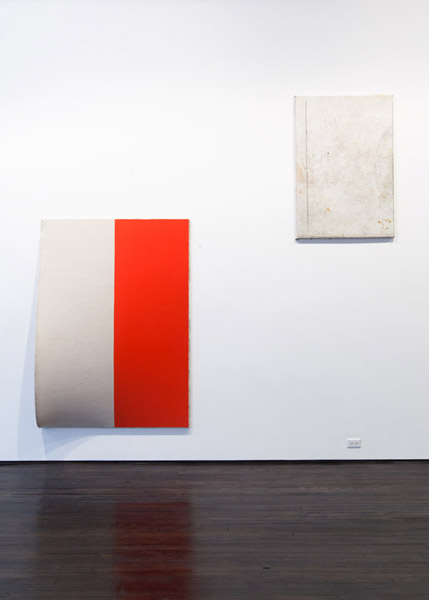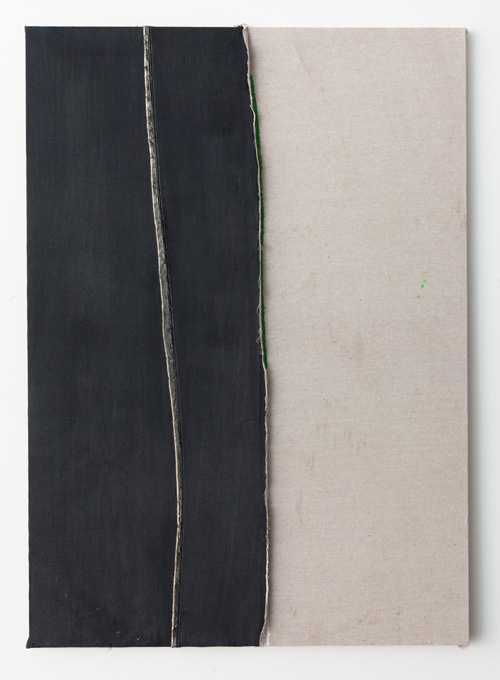
Jim Lee was born in Berrien Springs, Michigan and received his MFA from the University of Delaware in 1996. His current show in New York at Nicelle Beauchene runs until March 31. We met and became good friends in early 2001, shortly after moving to the city. We recently caught up to discuss his ever-evolving work, interests and life outside of the studio.
The full interview can be read on Burnaway
His work can be seen at Nicelle Beauchene Gallery

Installation View, 2013, courtesy of Nicelle Beauchene Gallery, New York
Ridley Howard: I've known you and your work for over 10 years now--can you talk about how the language of your paintings has developed? In terms of early interests, minor and major shifts that have led you to where you are now.
Jim Lee: As you know, I have a pretty manic personality. The work seems to feed off of that. I'm rarely content and that moves the paint around. Early on, the work was heavily oriented towards the structure. Even the drawings were in relief. Cardboard assembled in a quasi-haphazard fashion. The work was smallish in scale and I labored over a lot of minute details. At times, I felt like I had an idea of what each piece would look like before it was finished and I really didn't want that to be the situation.
I need to work and not really know that I am making anything in particular. I guess that's why I work on multiple pieces at the same time. It allows me to keep moving without focusing so much on the act of painting--in the end, I just want to make things. There shouldn't be any hierarchy in my process. Oil paint is no more important than latex, and linen is no more important than a piece of plywood. When I paint in this manner, the pieces become more interesting to me...I lose track of what is actually occurring.
Now it seems my painting is more traditional in terms of structure. Flat, lots of stretcher bars, canvas and linen. It's like the sanctity of the rectangle has won me over. All of this said, the work has basically remained about the same since the mid 90's. Looking back, I like what I was doing 10 years ago. It was a bit uglier, nastier and meaner.
You sort of mentioned this, but the structure and architecture of the paintings seems primary--structure as image/abstraction, structure of paint surface and stretcher, the architecture and space of the room. It all crumbles and materializes simultaneously.
For me, it's about staying engaged. The structure helps me to remain locked in. I try to slow people down...I want the viewer to discover things slowly; to have the paintings unveil themselves in a manner that takes time. I guess that's all part of it. The surface, stretcher, the environment--I want it all to be a factor. I imagine it being like when an athlete talks about the game slowing down... it's as if everything is functioning on the same level. I imagine it has something to do with confidence in one's approach.
Do you see your process as a kind of intervention? I've always thought about a Kelly-like elegance in tension with another disruptive energy.
That's funny. I like the term intervention when referring to my painting process. Sure, I guess there is a sort of intervention occurring. I just try to react off of things...marks on the painted surface, purposely warping a stretcher bar, cutting something then putting it back together. I want to create a scenario in which I have to fix something. In the end, I try to make a painting out of the happenstance that is part of the studio. And, over the years, I have tried to pare down the tools that I use. Having fewer tools forces me to make those decisions out of necessity. For a time, it felt like I was relying on the tools to inform what I would do next, and that seemed to inhibit my process. I had a big table saw that I would drag around with me from studio to studio. I built a giant table for it so I could roll it around, and it could easily rip a four by eight foot sheet of one-inch baltic birch. But in the end, I would be setting up all these jigs to make one or two cuts, and I would lose contact with the reality of the situation and it was like I was trying to make furniture. So, about 6 years ago, I just gave it away. I said to this guy I ran into in the neighborhood, if you can pick it up it's yours. He thought I was crazy, but was super excited to get it.

Station to Station II, 2013, Oil enamel, acrylic, rabbit skin glue on denim and cotton with staples, 62 1/4 x 44 inches, courtesy of Nicelle Beauchene Gallery, New York
Does your limited, but charged, use of color relate to that?
Color has been strange for me. I love to use it, but it has to fit with me just right. I love to mix colors when I teach my students, but in the studio I hate to mix color...it slows me down. I just want that immediacy. I think that's why I use a lot of industrial paints like oil-based enamels and such. I go to the store, tell them what colors I want...its ready to go. Just open up the can. I like to shop at the mom-and-pop hardware stores in the neighborhood. They always have some paints that are going out of stock, or they have decided to go with another brand and are selling cheap. I bought an industrial paint sprayer a few years ago--that provided a way to get color down really fast. It allows for some chance to occur at the same time it allows me to create a beautifully flat and nearly-dead surface. In the end, I believe that is something that I strive to achieve...a surface that is barely there...almost dead. I want to try to get the painting to be still for just a moment...it seems that the paintings are always moving too fast in my mind. I want them to slow down and not be all over the place.
Is there a concert or album that stands out to you in the way that Schwitters does?
That's a great question, but I doubt I have a fantastic answer. My recall ability is really poor. Many things are jumbled up in my mind. Band names, songs, titles to paintings, box scores, grocery lists...its endless. But a few weeks ago I had a visitor to the studio, and we were just sitting there shooting the shit and TV Eye by the Stooges came on the stereo. And I said, "I wish I could make a painting look like this sounds." I listened to TV Eye on repeat for an entire day. I do that with a lot of songs...Brother James by Sonic Youth is a good one for that, same for Bowie's Life on Mars?...go figure. It gets super strange after about nine or 10 hours of listening to the same song over and over. Maybe it's a way for me to deprive myself of information and it forces me to break rules I normally wouldn't attempt to break.

Installation View, 2013, courtesy of Nicelle Beauchene Gallery, New York